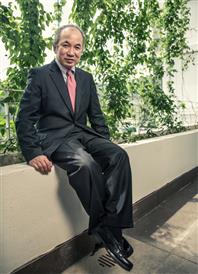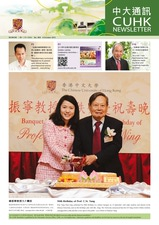What’s so fascinating about drugs?
Drugs have played a pivotal role in the impressive rise in life expectancy worldwide beginning with the introduction of penicillin in the 1940s. Drugs can be thought of as having multiple personalities. Aspirin is a case in point. Which personality would be expressed depends a great deal on the surroundings. As a kid, I was fascinated by how medicine made my fever and coughing magically go away. But pharmacy wasn’t on my radar screen then. My dream was to become an artist, but my dad convinced me otherwise. There’s an innate creativity in science, as there is in art. It may not be a coincidence that some scientists turn to art in their retirement. I used to make stained glass and do darkroom photography in my spare time. Now I indulge my creative side by reading and pondering about where the new technologies would lead us. My youngest son, a freshman in computer science, inherited my affinity for art. At the age of 4, he already had his mind made up on a career in designing sport cars!
How did you get into pharmacy in the US?
I was a student at Queen’s College on my way to try my luck at pursuing medicine at HKU. Instead my parents sent me to America after I finished Lower Form 6. They believed I would have a better future in America. Since an undergraduate degree was an admission requirement for medical school in the US, I selected pharmacy with the aim of getting a head start in expanding my knowledge in drugs. During my second year in pharmacy school, my aptitude for organic chemistry caught the attention of my professor, who introduced me to the world of research. There was no turning back.
You were also professor of ophthalmology at the University of Southern California. Could you tell us a little about drugs for the eyes?
I led an NIH-funded research programme in optimizing ocular drug therapeutics for more than two decades. The eye is a perfect example of paradox. It is accessible, yet it does not allow more than 1% of the instilled dose to be absorbed. The remainder may find its way into the bloodstream, thereby posing a drug safety concern. This is especially relevant for children and seniors. As we age, the risk of developing age-related macular degeneration increases. Patients cannot see well and conceivably may not even be able to distinguish among the other drugs they also have to take. About one out of three elderly has some vision loss. Nevertheless, potent medicine is available but only by direct injection into the eye, either monthly or bimonthly, to slow down or halt the deterioration in vision. This is a risky procedure that probably is inconvenient to the patient. Clearly, a non-invasive way for administering vision-saving medicine into patients’ eyes is urgently needed.
How would you like to see the school develop in terms of teaching, research and academic links?
Currently, the teaching and administrative load of our teaching staff per capita is relatively high. In anticipation of the increase in staff with a rise in student quota, the school should seize this opportunity to raise its research profile. It should be so bold as to champion the cause of establishing a regional clinical trial centre for Asia, akin to the NIH Clinical Center, that would attract the sponsors of complex clinical trials and top-notched clinical scientists to join and elite postgraduate students to be trained.. We cannot do this alone. We must engage our network of sister institutions.
I like to see our school continue its leadership role in improving the standard of pharmacy practice, and, in turn, health care, in Hong Kong. Our Master of Clinical Pharmacy Programme has been very successful. Our brand-new Master of Science Programme in Pharmaceutical Manufacturing and Quality has the capacity of lifting the quality standard of pharmaceuticals manufactured in Hong Kong.
Does being an expert in pharmaceuticals make you particularly sensitive to how people use prescription drugs?
There’s a silent epidemic of prescription drug misuse or abuse worldwide. Our over-burdened health care system has tried to cope with the avalanche of patients by providing those with chronic diseases lots of pills for as long as three to four months. This is a recipe for adverse drug events. As a beneficiary of the Hong Kong health care system by way of my Parkinson’s disease, I can pinpoint the gaps in drug safety that pharmacists are most qualified to fill.
You designed the logo of the School of Pharmacy. Tell us about it.
The credit for the artwork belongs to the anonymous artist. But when I had the idea for the logo, I wanted it to be differentiating. Pharmacy is a science-based profession. The logo captures this theme, which drives the translation of scientific advances into safe, efficacious, and affordable medicine. The blue ribbon represents the school, the green its students, staff and alumni. Together the two arms trace out the shape of a double helix, which happens to be the mathematical symbol for infinity. I am curious to learn what you see in the logo of our school. 


































































































































































Social Bookmarks